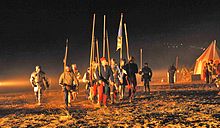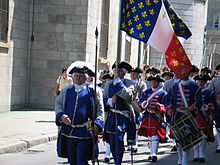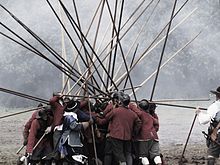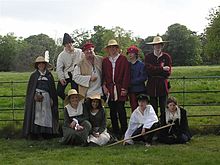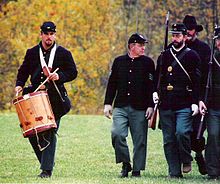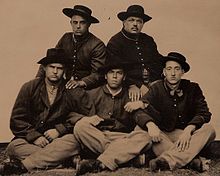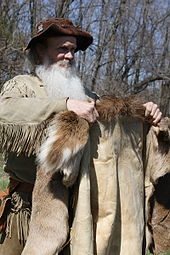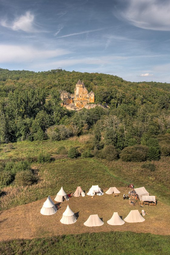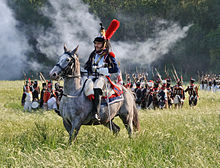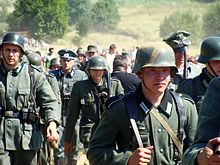- Historical reenactment
-
- "Reenactment" redirects here. For the 1968 Romanian film, see The Reenactment.
Historical reenactment is an educational activity in which participants attempt to recreate some aspects of a historical event or period. This may be as narrow as a specific moment from a battle, such as the reenactment of Pickett's Charge at the Great Reunion of 1913, or as broad as an entire period, such as Regency reenactment or The 1920s Berlin Project.
Contents
Historical reenactment through the ages
Activities related to "reenactment" have a long history. The Romans staged recreations of famous battles within their amphitheaters as a form of public spectacle. In the Middle Ages tournaments often reenacted historical themes from Ancient Rome or elsewhere. In the nineteenth century, reenactments were popular in a number of countries, e.g. the Eglinton Tournament of 1839 in Britain. During the early twentieth century they were popular in Russia with re-enactments of the Siege of Sevastopol (1854–1855) (1906), the Battle of Borodino (1912) in St Petersburg and the Taking of Azov (1696) in Voronezh in 1918. In 1920, there was a reenactment of the 1917 Storming of the Winter Palace on the third anniversary of the event. It was this reenactment which provided the inspiration for the scenes in Sergei Eisenstein's film October: Ten Days That Shook the World.
Likewise, mass pageants were used to commemorate civic events like 150th anniversary of the founding of St Louis, held in 1914.[1]
Living history
The term living history describes attempts to bring history to life for the general public. Historical reenactment includes a continuum from well researched attempts to recreate a known historical event for educational purposes, through representations with theatrical elements, to competitive events for purposes of entertainment. The line between amateur reenactment and presentations at living history museums can be blurred as, while the latter routinely utilize museum professionals and trained interpreters to help convey the story of history to the public, some museums and historic sites employ reenactment groups with high standards of authenticity for the same role at special events.
Reenactors
Most reenactors are amateurs who pursue reenactment as a hobby. Participants within this hobby are extremely diverse. The ages of participants range from young children whose parents bring them along to events, to the elderly. Among adult participants, people from all different walks of life can be found – college students, firefighters, lawyers, members of the armed forces, doctors, and even professional historians.
Reenactment groups
Reasons for participating
Reasons given for participating vary. Some participants are interested in getting a historical perspective on a particular period or war, particularly if they can trace their ancestry back to an individual or individuals who were involved.[citation needed] Others participate for the escapism that such events offer.[citation needed]
Categories of reenactors
Reenactors are commonly divided (or self-divide) into three categories, based on the level of concern for authenticity.[2][3]
Farbs
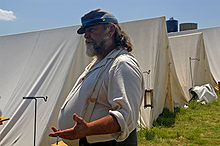 Some reenactors would consider this American Civil War reenactor "farby" because of his weight, as well as the modern cigarette he is holding.
Some reenactors would consider this American Civil War reenactor "farby" because of his weight, as well as the modern cigarette he is holding.
Some, called "Farbs" or "polyester soldiers",[4] are reenactors who spend relatively little of their time or money maintaining authenticity with regard to uniforms, accessories, or even period behavior. A 'Good Enough' attitude is pervasive among farbs, although even casual observers may be able to point out flaws. Anachronistic clothing, fabrics, fasteners (such as velcro), snoods, footwear, vehicles, and modern cigarettes are common issues.
The origin of the word "farb" (and the derivative adjective "farby") is unknown, though it appears to date to early American Civil War centennial reenactments in 1960 or 1961.[5] Some think that the origin of the word is a truncated version of "Far be it from authentic".[6] An alternative definition is "Far Be it for me to question/criticise",[7][8] or "Fast And Researchless Buying".[9] Some early reenactors assert the word derives from German Farbe, color, because inauthentic reenactors were over-colorful compared with the dull blues, greys or browns of the real Civil War uniforms that were the principal concern of American reenactors at the time the word was coined.[10][11] According to Mr. Burton K. Kummerow, a member of "The Black Hats, CSA" reenactment group in the early 1960s, he first heard it used as a form of fake German to describe a fellow reenactor. The term was picked up by George Gorman of the 2nd North Carolina at the Centennial Manassas Reenactment in 1961, and has been used by reenactors ever since.[12]
Mainstream
Mainstream reenactors make an effort at appearing authentic, but may come out of character in the absence of an audience. Visible stitches are likely to be sewn in a period-correct manner, but hidden stitches and undergarments may not be period-appropriate. Food consumed before an audience is likely to be generally appropriate to the period, but it may not be seasonally and locally appropriate. Modern items are sometimes used "after hours" or in a hidden fashion. The common attitude is to put on a good show, but that accuracy need only go as far as others can see.[citation needed]
Progressive
At the other extreme from farbs are "hard-core authentics", or "progressives," as they prefer to be called.[13] Sometimes derisively called "stitch counters"[14], "authenticity nazis" or even "stitch nazis", many people have misconceptions about hardcore reenactors.[15]
Hard-core reenactors generally value thorough research, and sometimes deride mainstream reenactors for perpetuating inaccurate "reenactorisms". They generally seek an "immersive" reenacting experience, trying to live, as much as possible, as someone of the period might have. This includes eating seasonally and regionally appropriate food, sewing inside seams and undergarments in a period-appropriate manner, and staying in character throughout an event.[16] The desire for an immersive experience often leads hard-core reenactors to smaller events, or to setting up separate camps at larger events.[17]
Period
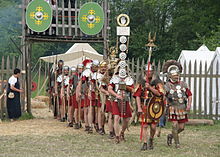 Reenactment covers a wide time span. This is a reenactment of the Roman legion XV Apollinaris, taking place in Austria.
Reenactment covers a wide time span. This is a reenactment of the Roman legion XV Apollinaris, taking place in Austria.
The period of an event is the range of dates. See authenticity (reenactment) for a discussion of how the period affects the types of costume, weapons, and armour used.
Popular periods to reenact include:
- Classical reenactment
- Medieval reenactment
- Renaissance reenactment (including English Civil War reenactment)
- Modern reenactment
- Regency reenactment[citation needed]
- The Fur Trade is reenacted at events called as "Rendezvous".[citation needed]
- American Civil War reenactment[2]
- World War I reenactment[18]
- World War II reenactment[citation needed]
- Korean War reenactment[citation needed]
Clothing and equipment
Numerous cottage industries abound that provide not only the materials but even the finished product for use by reenactors. Uniforms and clothing made of hand woven, natural dyed materials are sewn by hand or machine using the sartorial techniques of the period portrayed.
Detailed attention to authenticity in design and construction is given equally as well to headgear, footwear, eyewear, camp gear, accoutrements, military equipment, weapons and so on. These items (which are generally much more expensive than clothing and uniform in modern production) offer the wearer a life-like experience in the use of materials, tailoring and manufacturing techniques that are as close to authentic as possible.
Event spectators may derive more satisfaction from attending reenactments when a high level of authenticity is attained in both individual clothing and equipment, as well as equipment used in camp.
Types of reenactment
Living history
Living histories are usually meant for education of the public. Such events do not necessarily have a mock battle but instead are aimed at portraying the life, and more importantly the lifestyle, of people of the period. This often includes both military and civilian camps. Occasionally, storytelling or acting sketches take place to involve or explain the camps background to the viewing public. More common are craft and cooking demonstrations, song and leisure activities, and lectures. Combat training or duels can also be encountered even when larger combat demonstrations are not present.
In the United States, living history is the only reenactment permitted on National Park Service land; NPS policy "does not allow for battle reenactments (simulated combat with opposing lines and casualties) on NPS property."[19]
Combat demonstration
Combat demonstrations are mock battles put on by reenacting organizations and/or private parties primarily to show the public what combat in the period might have been like. Combat demonstrations are only loosely based on actual battles, if at all, and may simply consist of demonstrations of basic tactics and maneuvering techniques.
Battle reenactment
Scripted battles are reenactment in the strictest sense; the battles are planned out beforehand so that the companies and regiments make the same actions that were taken in the original battles.
They are often fought at or near the original battle ground or at a place very similar to the original. These demonstrations vary widely in size from a few hundred fighters to several thousand, as do the arenas used (getting the right balance can often make or break the spectacle for the public).
Tactical combat
Tactical battles are generally not open to the public. Tactical battles are fought like real battles with both sides coming up with strategies and tactics to beat their opponents. With no script, a basic set of agreed-upon rules (physical boundaries, time limit, victory conditions, etc.), and on-site judges, tactical battles can be considered a form of Live action role-playing game, but, in the cases where firearms are used, with real weapons firing blank ammunition (depending on gun control ordinances).
The development of "historical airsoft" tournaments is an offshoot of the military reenactment tactical.
Commercial reenactment
Many castles, museums, and other historical tourist attractions employ actors or professional reenactors as part of the experience. These usually address the recreation of a specific town, village, or activity within a certain time frame. Commercial reenactment shows are usually choreographed and follow a script.
Some locations have set up permanent authentic displays. By their nature, these are usually living history presentations, rather than tactical or battle reenactment, although some host larger temporary events.
Virtual reenactment
The virtual world Second Life contains several virtual reenactments of factual and fictional histories, e.g., The 1920s Berlin Project and Star Trek.
Publications
Many publications have covered historical reenactment and living history. Prominent among these are the Camp Chase Gazette, Smoke and Fire News, two different magazines named Living History, and Skirmish Magazine.
The Medieval Soldier by Gerry Embleton and John Howe (1995) is a popular book on the topic, which has been translated into French and German. It was followed by Medieval Military Costume in Colour Photographs.
For the Napoleonic Period there are two books of interest that cover life in the military at that time and living history: The Napoleonic Soldier by Stephen E. Maughan, 1999 and Marching with Sharpe by B.J. Bluth, 2001. Various Napoleonic reenactment groups now cover the history of their associated regiment as well as try to describe and illustrate how they approach recreating the period. The aim to be as authentic as is possible from the various source materials has led many serious reenactment societies to set up their own research groups to verify their understanding of the uniforms, drill and all aspects of the life that they strive to portray. In this way reenactment plays a vital role in bringing history to life, keeping history alive and in expanding the knowledge and understanding of the period.
In the UK a number of small publishing houses have been established to disseminate knowledge initially of the English Civil War but latterly of earlier periods as well. The largest are Stuart Press [around 250 volumes in print] and Partizan Press.
Media support
Motion picture and television producers often turn to reenactment groups for support; films like Gettysburg,[citation needed] Glory,[citation needed] The Patriot,[citation needed] and Alatriste[citation needed] benefited greatly from the input of reenactors, who arrived on set fully equipped and steeped in knowledge of military procedures, camp life, and tactics.
In a documentary about the making of the film Gettysburg, actor Sam Elliott, who portrayed Union General John Buford in the film, said of reenactors:
“ I think we're really fortunate to have those people involved. In fact, they couldn't be making this picture without them; there's no question about that. These guys come with their wardrobe, they come with their weaponry. They come with all the accoutrements, but they also come with the stuff in their head and the stuff in their heart. ” Criticism
It is often difficult for veterans or the public to understand why reenactors do what they do, or there may be questions as to the motivation, or the level of knowledge of the reenactors.
Common criticisms revolve around motivation, as well as concerns about the level of immersion found in some arenas, notably those involving 20th Century conflicts where combatants had stricter regulations regarding personal grooming.[21] The average age of reenactors is also generally far higher than the average age of soldiers in most conflicts. Few reenactment units discriminate, however, based on age and physical condition.[22] However, there has been criticism about the exclusion of women from some American Civil War combat reenactment units. While there were a small handful of women who may have fought in the conflict, almost all of them did so disguised as men. Attitudes on this topic seem to vary widely.[23]
Another concern mentioned by Thompson's book is the "fantasy farb", or tendency of reenactors to gravitate towards "elite" units such as commandos, paratroopers, or Waffen-SS units resulting in an under-representation in the reenactment community of what were the most common types of military troops in the period being reenacted. This is largely drawn from a North American perspective, although there are parallel issues on the European scene, such as the tendency in Britain for Napoleonic War reenactors to perform as members of the 95th Rifles (perhaps due to the popularity of Sharpe) and larger proportions of plate-armoured soldiers in later medieval groups. In the UK there are multi-period events such as 'History in Action' where groups get to look at each other's appearance and performances as well as perform for the general public. One other concern which can cause misunderstandings are in countries where weapons of most forms are legally or socially frowned upon (such as in the UK). Reenactors own interactions with the public, and the work of volunteer groups like NARES,[24] help to mitigate such issues.
A final concern is that reenactors may become, or already be, too closely aligned to the controversial political beliefs that some of the reenacted armies fought for, such as Nazism, or the Confederate South. For example, Rich Iott's participation in a World War II reenactment group portraying the Nazi 5th SS Panzer Division Wiking attracted considerable media attention during his 2010 Congressional campaign.[25]
External links
- TheReenactor.com, International reenactment database & wiki. All periods & culture.direct link to the wiki,
- Reenacting.eu, International website of living history. All periods.
- Reenactor.Net, International website of living history. All periods.
- The Historical Reenactment Web Site, Information relating to reenactment globally and the home of The Historical Reenactment Wiki
- Ancient Warfare Magazine
- Skirmish Magazine, The world's leading living history and re-enactment monthly, published in the UK
- Russian reenactor forum 17-19AD
- The film director Lawrence Hott on re-enactments
Notes
- ^ Bolshevik Festivals, 1917–1920 by accessed 7 December 2008
- ^ a b Strauss. "In the United States, hobby organizations participate in the public reenactment of historical events. The most popular is Civil War reenacting, which can be viewed as a manifestation of the unresolved nature of that war...Among reenactors, the quest for historical authenticity is considered a core value."
- ^ Stanton. p 34
- ^ Hadden p 209 and p 219
- ^ Hadden p 8 Ross M. Kimmel states that it was used at the Manassas reenactment in 1961...George Gorman and his 2nd North Carolina picked up the term at the First Manassas Reenactment in 1961 and enjoyed using it constantly with condescension and sarcasm directed toward other units.
- ^ Horwitz, Tony (1994-06-02), "They Don Period's Clothes, Eat Era's Grub and Sneer At Less-Exacting Brethern", Wall Street Journal, http://wesclark.com/jw/hodge.html, retrieved 2011-01-03, "Some also refuse to fight beside those whose uniforms and performance art don't measure up: a group derided as "farbs," short-hand for "far-be-it-from-authentic.""
- ^ Hadden, p 8
- ^ Wesclark.com
- ^ Hadden p 8 Juanita Leisch calls it "Fast And Researchless Buying," and other sources insist it came from the Bicentennial and Revolutionary War groups and means "Fairly Authentic Royal British."
- ^ Hadden p8
- ^ Worldwidewords.org
- ^ Hadden, p 219-220
- ^ Hadden p 138
- ^ Hadden p 224
- ^ Hadden, p 138 "The hard-core movement is often misunderstood and sometimes maligned."
- ^ Hadden p 138 "Like soldiers of the Civil War, progressives experience the same poor conditions that the original soldiers did, camping without tents and sleeping out exposed to the cold and rain. They spend weekends eating bad and insufficient food, and they practice a steady regimen of work, marching, and drill. They suffer the cold, carrying insufficient clothing and blankets as well as sleeping campaign-style by spooning with each other for warmth."
- ^ Hadden p 139
- ^ [1]
- ^ "Wilson's Creek National Battlefield FAQ". National Park Service. 25 July 2008. http://www.nps.gov/wicr/faqs.htm.
- ^ This documentary can be found on the DVD of the film Gettysburg.
- ^ Thompson, Jenny. Wargames: Inside the World of 20th Century Reenactors (Smithsonian Books, Washington, 2004). ISBN 1-58834-128-3
- ^ Thompson, op.cit.
- ^ "Women Military Reenactor's Homepage". Archived from the original on 15 May 2005. http://web.archive.org/web/20050515205452/http://www.geocities.com/womansoldier/. Retrieved 29 October 2009.
- ^ Nares.org.uk
- ^ US Republican candidate Rich Iott in Nazi uniform row, BBC News, 2010-10-10, http://www.bbc.co.uk/news/world-us-canada-11511574, retrieved 2011-06-30
References
- Hadden, Robert Lee. "Reliving the Civil War: A reenactor's handbook". Mechanicsburg, PA: Stackpole Books, 1999.
- Heiser, John (1998-09). "The Great Reunion of 1913". National Park Service. http://www.nps.gov/archive/gett/getttour/sidebar/reunion13.htm. Retrieved 15 August 2008.
- John Skow, et al., "Bang, Bang! You're History, Buddy," Time (August 11, 1986): 58.
- Stanton, Cathy (1999-11-01). "Reenactors in the Parks: A Study of External Revolutionary War Reenactment Activity at National Parks" (PDF) National Park Service. Retrieved on 2008-07-28.
- Strauss, Mitchell (2001). "A Framework for Assessing Military Dress Authenticity in Civil War Reenacting". Clothing and Textiles Research Journal (International Textile & Apparel Association, Inc.) 19 (4): 145–157. doi:10.1177/0887302X0101900401. http://ctr.sagepub.com/cgi/content/abstract/19/4/145. Retrieved 31 December 2008.
Historical reenactment Concepts Event types Periods Classical · Medieval (Dark Ages, Viking) · Renaissance (English Civil War, Renaissance fairs) · Modern (American Civil War, Fur trade, Regency, World War I, World War II, Korean War)Fandom By type GenreMedium-specificDemographics Organizations and events Publications and activities Fan fiction · Fanzine · amateur press association · Fan art · Fansite · Fanspeak · Fan edit · Fan mail · Fan translation · Filk music · Fan laborConventions by topicby fundingCategories:
Wikimedia Foundation. 2010.

